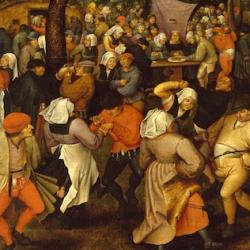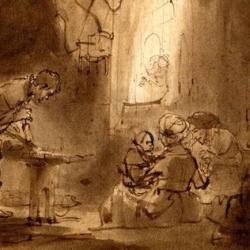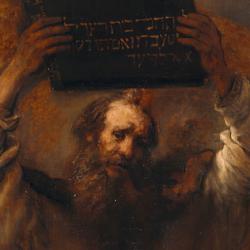In his 1993 Word and Glory: On the Exegetical and Theological Background of John’s Prologue (Library of New Testament Studies) (79-82), Craig A. Evans lays out five parallels between the account of Moses’ intercession at Sinai (Exodus 33-34) and the latter part of the Johannine prologue (1:14-18):
First, the general contrast of Moses and Jesus, between the “grace” of the Mosaic order and the “grace in place of grace” that comes with Jesus. Second, Moses asks to seek the glory of God (Exodus 33:18), a glory displayed in the Word made flesh (John 1:14). Third, Yahweh tells Moses “You cannot see My face” (Exodus 33:20), which is directly alluded to in John 1:18. Fourth, the Word/Son who is in the “bosom” of the Father (John 1:18) and “toward” the Father (1:1) contrasts with Moses’ brief encounter with the “back” of God (Exodus 33:23). Finally, the Word is “full of grace and truth” (John 1:14), as Yahweh’s name declares that He abounds in “love and faithfulness” (Exodus 34:6). Evans concludes that “in essence . . . the second half of the Johannine Prologue presupposes the second half of the book of Exodus (Exodus 20-40), which tells of Israel’s meeting with God at Sinai” and of course His meeting eventually in the tent.
He notes that John 1 is also tracking Genesis 1. He suggestively says that the connection between creation and covenant, he says, is “primarily with respect to the Sabbath,” but leaves the point undeveloped. It might be possible to explain the overlap of Genesis and Exodus in John by noting the more extensive parallels between creation and tabernacle in Exodus.
As a number of commentators have noted, the tabernacle texts of Exodus 25-31 are organized in seven speeches that roughly match the days of creation. The sixth speech, for instance, describes the new “Adams,” Bezalel and Oholiab, equipped by the Spirit of Yahweh with skill for making tabernacle furnishings (Exodus 31:1-11). The sequence ends with a reiteration of the Sabbath command (Exodus 31:12-17). Then Israel turns from Yahweh and worships the golden calf (Exodus 32), a fall scene that recalls Genesis 3.
In this sequence, the intercession of Moses on Sinai parallels the protoevangelium of Genesis 3: Despite Adam’s sin, Yahweh promises deliverance through the seed of the woman; similarly, despite Israel’s idolatry, Yahweh promises to dwell among them and take them to the land in fulfillment of His promise. The big difference between the two scenes is the presence of a mediator: In the garden, Yahweh appears directly to Adam to judge and promise; in Exodus Moses stands between Yahweh and the offending “Adamic” people.
Now, overlay this already complex sequence onto John’s prologue. What does it tell us? It suggests that the tabernacling of the Word is a “sabbatical” event. It also suggests that the tabernacling of the Word involves a renewal of covenant after a fall. As in Genesis 1-3 and Exodus 33-34, the full realization of the Creator’s presence with His creation comes after a breach of covenant. In John 1, we’re told that the Word came to His own, but they do not receive Him. Yet John assures us that He tabernacles among us in spite of idolatry. He goes up with us to the promised land, He takes us back into Eden.














